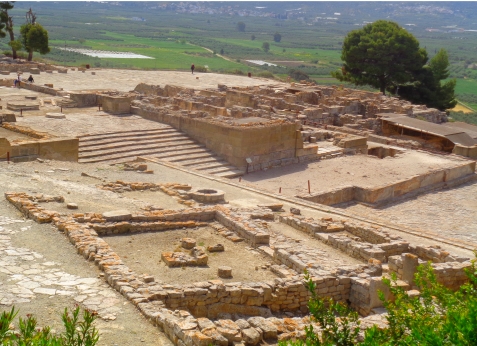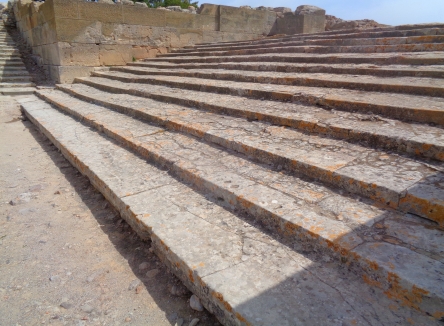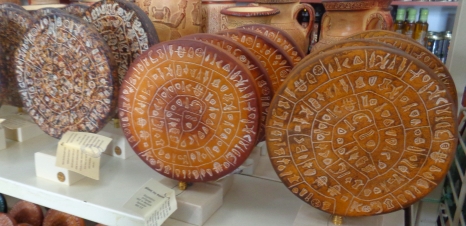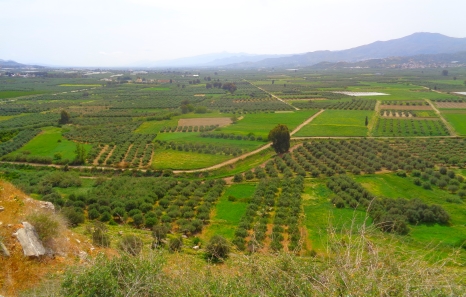|
Phaistos |
||
|
|
What do you see in Phaistos? To put it simply: The visit of the excavation of Phestos is interesting if you know your way around. If you have no idea, you can only see a few squares, stairs and many knee-high walls. It is best to take a good guide with you or take a guided tour. Whoever thinks that he sees many objects from antiquity like vessels, jewellery or even the famous discos of Phaistos will be rather disappointed. Practically all the sights found were brought to museums. This is necessary for safety reasons alone. In Festos everything is open-air, the area is only protected by a simple fence. The vast majority of the sightseeing of Phaistos does not even have a roof. On the site are three large squares of the very old palace. The wide stairs are also interesting. Otherwise you can see some buildings, but in most of them only parts of the walls and some smaller rooms are preserved or excavated. What was Phaistos anyway? The Minoans are considered to be the first high culture in Europe in the Bronze Age. They already knew metals, but no iron. They built several large palaces, including for their kings. The palace of Phestos was built around 1900 BC, so it is almost unbelievable 4000 years old. The palace of Phaistos is next to Knossos near Heraklion the most important palace of the Minoans on Crete. The excavations began around 1900 and are not yet finished after more than 100 years. The most famous find is the famous Ring of Phaistos. It is today with many other things from Phestos in the Archaeological Museum Crete in the city center of the Cretan capital Heraklion. Anyone who sees their holiday in Crete as an archaeological educational holiday should definitely visit Phaistos and Knossos. Ideally you should then go to the Museum of Archaeology in Heraklio, by far the most important museum on the island of Crete. Entrance fee Phaistos / Crete Adults pay 8 Euro entrance fee in Phestos. There is a reduced entrance fee of 4 euros. Opening hours Phasitos Crete According to our information Phaistos is open daily from 8 a.m. to 6 p.m. (during the season). Shop and gastronomy At the entrance, a staircase leads up to a shop with a café. Here you can buy souvenirs around the theme of Festos. These include copies of the famous discus of Phaistos, by far the most famous object found on the site.
There are also other souvenirs such as T-shirts and postcards. The cafe (self-service) is not too expensive. A small bottle of cold water costs only 50 cents, a can of cola 1.50 euros or a delicious puff pastry spinach bag 1.70 euros. The toilet is free. You can enter the shop without paying the entrance fee, the ticket account is only behind it. View from Festos Since Phestos is built on a hill, one has a great view of the large Massara plain with many olive trees and plantations. Opposite you can see the mountains and peaks of Plilorotis, the highest mountain in Crete. Until the end of May the summit is covered with snow. With good visibility you can take great photos of the area of the excavation of Phaistos.
Directions and parking There is a larger parking lot about 100 meters from the entrance of Phaistos for the many tourists with the rental cars and buses of the organizers of day trips. During the season several thousands of tourists come to Phestos every day. During our visit in April 2017 parking was free. It also did not indicate that parking costs anything in summer. From the parking place, one walks approximately 3 minutes to the entrance. One passes a meter-high cactus, also a popular motive for photos. Take the signposted turnoff at the road between Mires and Timbaki heading south towards Phaistos. Coming from Matala and Kalamaki, Phaistos is also well signposted. If you can't find the palace on the map: The next village is called Agios Ioannis, the next cities are Timbaki and Mires. Another excavation is near Phestos (about 5 km) is Agia Triada, the nearest beach is in Kalamaki (Komos beach). Pitsidia is a great, old village not far away.
|
|



